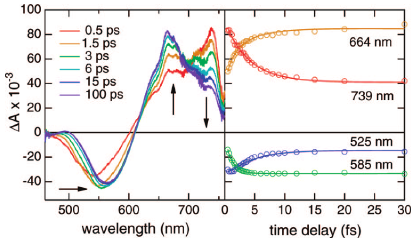The excited-state dynamics of covalently linked electron donor−acceptor systems consisting of N,N-dimethylaniline (DMA) as electron donor and either perylene (Pe) or cyanoperylene (CNPe) as acceptor has been investigated in a large variety of solvents, including a room-temperature ionic liquid, by using femtosecond time-resolved fluorescence and absorption spectroscopy. The negligibly small solvent dependence of the absorption spectrum of both compounds and the strong solvatochromism of the fluorescence are interpreted by a model where optical excitation results in the population of a locally excited state (LES) and emission takes place from a charge-separated state (CSS). This interpretation is supported by the fluorescence up-conversion and the transient absorption measurements that reveal substantial spectral dynamics in polar solvents only, occurring on time scales going from a few hundreds of femtoseconds in acetonitrile to several tens of picoseconds in the ionic liquid. The early transient absorption spectra are similar to those found in nonpolar solvents and are ascribed to the LES absorption. The late spectra due to CSS absorption show bands that are red-shifted relative to those of the radical anion of the acceptor moiety by an amount that depends on solvent polarity, pointing to partial charge separation. Global analysis of the time-resolved data indicates that the charge separation dynamics in PeDMA is essentially solvent controlled, whereas that in CNPeDMA is faster than diffusive solvation, this difference being accounted for by a larger driving force for charge separation in the latter. On the other hand, the CSS lifetime of PeDMA is of the order of a few nanoseconds independently of the solvent, whereas that of CNPeDMA decreases with increasing solvent polarity from a few nanoseconds to a few hundreds of picoseconds. Comparison of these results with previously published data on the fluorescence quenching of Pe and CNPe in pure DMA shows that the charge separation and the ensuing charge recombination occur on similar time scales independently of whether these processes are intra- or intermolecular. |




